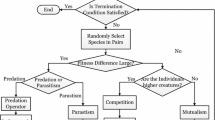Abstract
Competitive co-evolutionary algorithms (CCEAs) have many advantages, but their range of applications has been crucially limited. This study provides a simple, non-problem-specific framework to extend that range. The framework has two co-evolving populations, one of candidate solutions and one of criteria, in which these populations competitively co-evolve with each other. The framework aims to avoid candidate solutions getting stuck in a local optimum by changing the fitness landscape dynamically. Moreover, the framework has a mechanism which will establish and maintain a proper arms race. We have conducted experiments on two function optimization problems, the 1-dimensional function maximization problem and the Rastrigin function minimization problem, in order to investigate the basic properties of the framework. The results of the experiments showed that a CCEA achieves a performance which is comparable to that of a GA.
Similar content being viewed by others
Explore related subjects
Discover the latest articles, news and stories from top researchers in related subjects.References
Hillis WD (1992) Co-evolving parasites improve simulated evolution as an optimization procedure. Artificial Life II, Addison-Wesley, CA, USA, pp 313–324
Juillé H, Pollack JB (1998) Co-evolutionary learning: a case study. Proceedings of the 15th International Conference on Machine Learning, Madison, WI, USA, pp 251–259
Rosin CD (1997) Co-evolutionary search among adversaries. PhD Thesis, University of California, San Diego
Paredis J (1994) Co-evolutionary constraint satisfaction. Parallel Problem Solving from Nature-PPSNIII, Springer, London, pp 46–55
Cartlidge J, Bullock S (2004) Combating co-evolutionary disengagement by reducing parasite virulence. Evolut Comput 12(2): 193–222
Baker JE (1987) Reducing bias and inefficiency in the selection algorithm. Proceedings of the 2nd International Conference on Genetic Algorithms, Lawrence Erlbaum Associtates, NJ, USA, pp 14–21
Goldberg DE, Richardson J (1987) Genetic algorithms with sharing for multimodal function optimization. Proceedings of the 2nd International Conference on Genetic Algorithms, Lawrence Erlbaum Associtates, NJ, USA, pp 41–49
Whiteley D, Rana SB, Dzubera J, et al. (1996) Evaluating evolutionary algorithms. Artif Intell 85(1–2):245–276
Author information
Authors and Affiliations
Corresponding author
Additional information
This work was presented in part at the 14th International Symposium on Artificial Life and Robotics, Oita, Japan, February 5–7, 2009
About this article
Cite this article
Sato, T., Arita, T. Competitive co-evolutionary algorithms can solve function optimization problems. Artif Life Robotics 14, 440–443 (2009). https://doi.org/10.1007/s10015-009-0721-y
Received:
Accepted:
Published:
Issue Date:
DOI: https://doi.org/10.1007/s10015-009-0721-y




